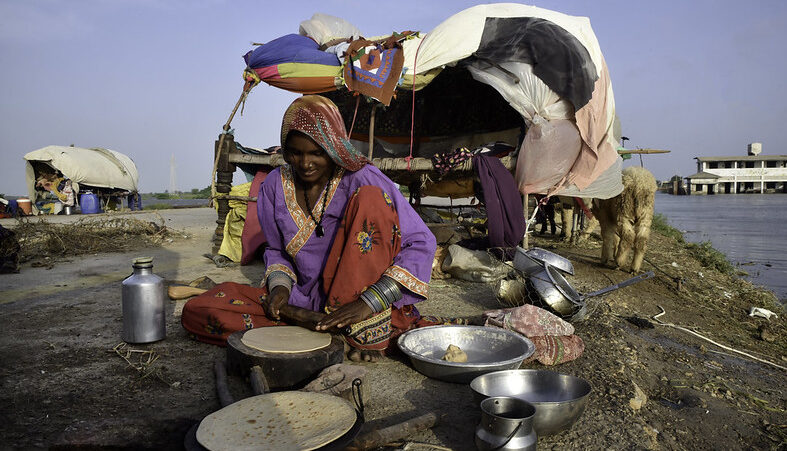The Office for the Coordination of Humanitarian Affairs had only seven staff in Islamabad to assess the needs, down from 35 five years earlier
Six months on from the start of devastating floods in Pakistan, about 200,000 people are still displaced – living under tarpaulins by the side of the road.
As summer turned to winter, some parts of the country have seen snow. “For children and old age people without shelter, it’s terrible,” said Concern Worldwide’s Sherzada Khan.
Young women and girls are still “forced to live without roof and walls,” he added, putting them at risk of sexual assault.
On top of this, he said “[a] severe food security crisis [is] looming now and will be there until the next harvest”.
With stagnant flood water still around in some places, malaria is rife at the time of year it should be minimal, according to Ed Taylor from Médecins Sans Frontières.
Taylor and his colleagues are giving out bed nets to vulnerable people to keep the mosquitos out. But, he says, this needs to be done on a bigger scale by the UN.
“We haven’t scaled up nearly enough to meet the size of the challenge,” he said.
Asif Sherazi, head of Islamic Relief Pakistan, agreed. “Humanitarians have failed in this disaster”, he told Climate Home.
Several relief workers involved in the response to the floods said this failure was partly because the cash-strapped UN cut back its humanitarian team in Pakistan just before the floods hit.
Ocha’s budget cuts
The UN’s Office for the Coordination of Humanitarian Affairs (Ocha) has headquarters in Geneva and New York and staff in 60 countries, mostly in low and middle income countries.

Ocha has staff in 60 countries, mostly in the global south
When disaster strikes – through storms, earthquakes, war or disease – its job is to raise money from around the world and coordinate an international relief effort.
This job has been getting harder, as climate change kicks in. The number of climate-related disasters like floods and storms in the 2010s was double what it was in the 1980s.
While needs have soared, the amount of money Ocha gets from wealthy governments – about 95% of its total income – has stagnated. In 2015, it got $334 million. By 2020, this had dropped to $307m.
Since 2020, as the Covid-19 pandemic and energy inflation took an economic toll, several rich countries tightened their belts further.
As Ocha’s budget fell, so did its staff numbers. The organisation employed 2,300 people in 2015 and now employs 2,000.
Ocha in Pakistan
Pakistan was not spared from these cutbacks. At the end of 2021, Ocha downgraded its presence from a full "country office" to a "humanitarian advisory team" reporting to Ocha's regional office in Bangkok, Thailand.
That meant its team in Islamabad didn't produce a humanitarian response plan for 2022, as they had for the years before.
In 2016, Ocha had around 35 staff in Pakistan and a budget of more than $5m. By 2021, its budget was $1.1m and in 2022 it employed seven people.
So when flooding started in July 2022, it had a netball team's worth of people in the country to survey the damage. Ocha sent staff over from Bangkok and elsewhere, upping the headcount to 25-30 people by the end of the year.
But Abid Suleri, who sits on the board of directors of Pakistan's National Disaster Risk Management Fund, told Climate Home that cuts to Ocha in Pakistan "did have an impact" on its response.
Anam Zeb, who worked at the National Disaster Risk Management Fund when the floods hit, said Ocha was "not as visible as it was before", particularly in carrying out needs assessments.
Another humanitarian, who works with Ocha and so did not want to be named, said: "Ocha did not have the presence in Pakistan to co-ordinate everything." They added that they did not have the r
Read More

